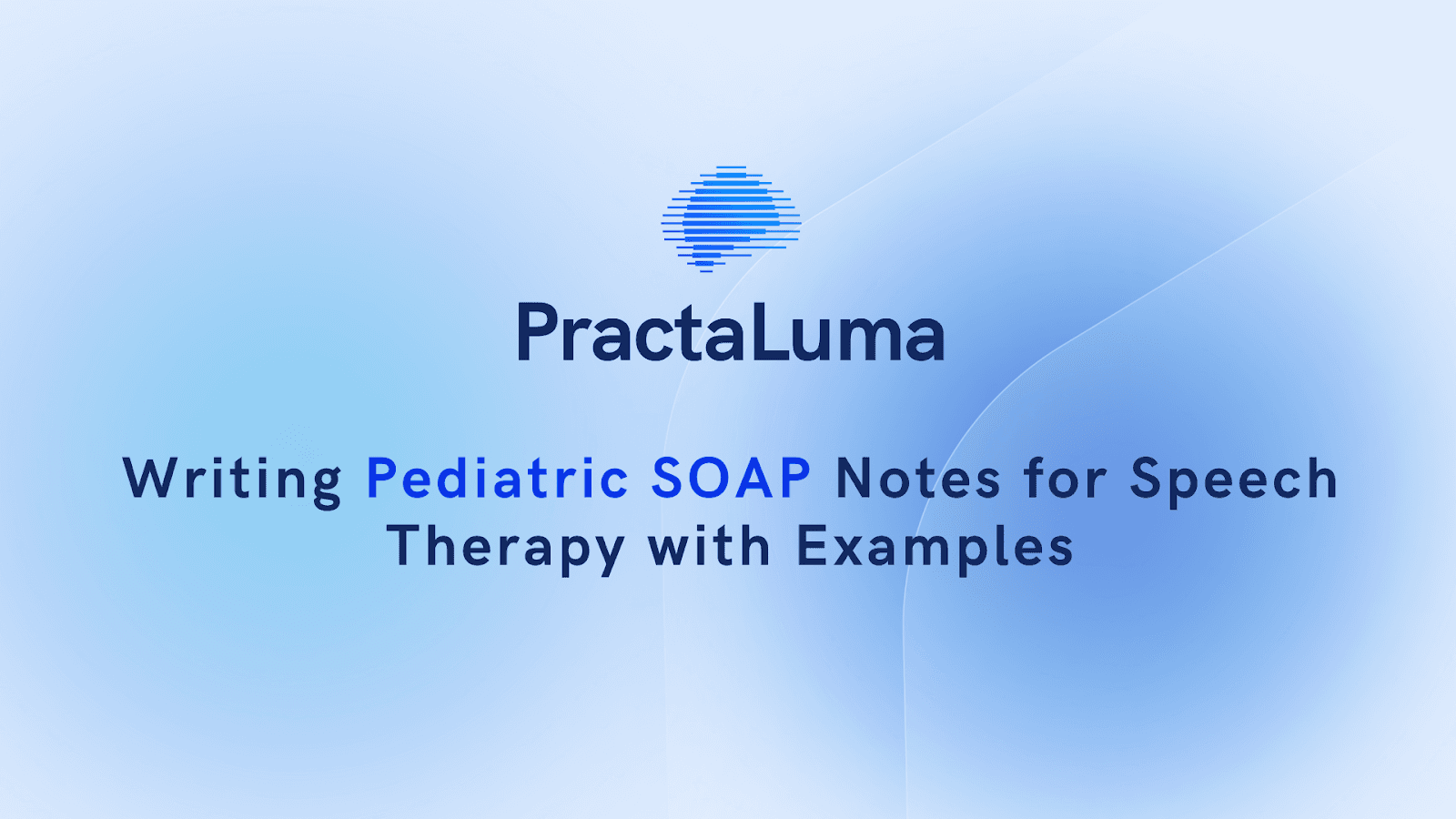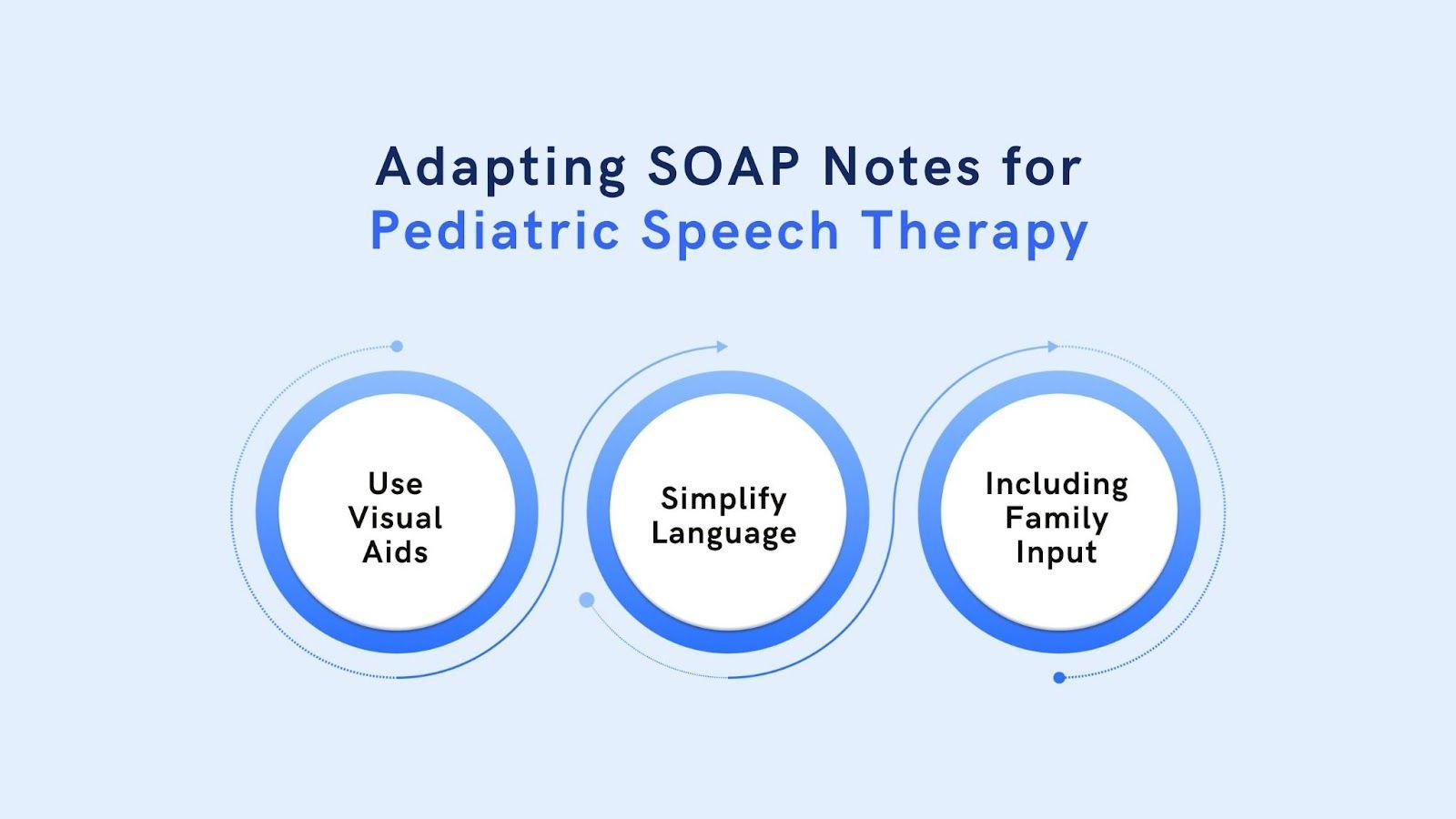
5 May 2025
Writing Pediatric SOAP Notes for Speech Therapy with Examples
Pediatric SOAP notes for speech therapy are more than just a formality—they are important for documenting a child’s progress, understanding their needs, and planning future sessions.
The SOAP format—for Subjective, Objective, Assessment, and Plan—is a standardised system allowing speech therapists to maintain clear, concise, and structured records.
However, when working with children, these notes must be crafted with attention to detail and context to capture a comprehensive view of the child's therapy journey. Let's explore the importance of writing pediatric SOAP notes for speech therapy.
The Importance of Pediatric SOAP Notes in Speech Therapy

Speech therapy is essential for children, especially toddlers or preschoolers, as it helps develop vital communication skills, aiding social interactions, academic success, and emotional well-being.
SOAP notes are indispensable in pediatric speech therapy, providing a consistent framework for documenting each child’s unique progress and challenges. More than just a record, these notes foster better communication with caregivers and other healthcare professionals, ensuring your treatment approach remains effective.
Why do SOAP Notes Matter in Pediatric Speech Therapy?
Consider pediatric SOAP notes for speech therapy as the backbone of a child’s therapeutic progress. They ensure:
1. Objective Tracking: SOAP notes provide measurable data that helps track a child’s growth and inform future treatment strategies. These notes offer clarity, whether noting improvements in speech fluency or documenting challenges.
2. Regulatory Compliance: Proper documentation ensures your sessions meet the required standards for legal and ethical practice, safeguarding your practice and maintaining trust.
3. Effective Communication: SOAP notes help you align with families and caregivers. When everyone is on the same page, progress becomes more transparent.
As a clinician, your time is valuable. Streamlining the documentation process can be a game-changer.
Breaking Down the Pediatric SOAP Note Structure
Now that we understand the importance of SOAP notes, let’s explore each component in detail. This structure is your roadmap for understanding and documenting every aspect of a child’s speech therapy session.
1. Subjective: Gathering Insights from the Child and Family
The Subjective section focuses on the child and their family’s perceptions. It includes feedback from parents, caregivers, and children, highlighting areas of concern or progress.
Example:
The mother reports that her child is becoming increasingly frustrated when asked to speak in front of peers at school.
Here, you capture the emotional context and any behavioural observations that could influence the child's therapy outcomes.
Staying organised and efficient is essential as we dive deeper into the documentation process.
2. Objective: The Hard Data and Measurable Observations
In the Objective section, you document quantifiable, observable data—everything from articulation accuracy to the frequency of stuttering or language use. This is where you record how the child performed in measurable terms.
Example:
The child produced the target sound correctly in 70% of trials during the session.
Keeping this section focused on objective observations provides a solid foundation for the subsequent assessment. It’s the most factual part of the SOAP note, so it’s essential to be specific and clear.
3. Assessment: Analysing the Data and Drawing Conclusions
The Assessment section ties the Subjective and Objective components together. It’s where you evaluate the child’s progress, identify ongoing challenges, and compare the current session to previous ones. This section analyses the data and draws insights that will guide future treatment.
Example:
The child’s fluency has improved, though anxiety still contributes to occasional disruptions during group activities.
In this phase, your subjective and objective data interpretation is critical. It helps you understand why specific progress is happening and what adjustments may be necessary for better outcomes.
4. Plan: Charting the Path Forward
The Plan section outlines the next steps. It details goals for future sessions, adjustments to therapy techniques, and any new strategies you will implement to address areas of concern.
Example:
Continue to target speech fluency using controlled practice in structured activities. Plan to introduce breathing exercises to manage anxiety.
This part of the SOAP note should be action-oriented, with clear goals and a well-thought-out approach for moving forward.
Let us look at some real-life examples of pediatric SOAP notes for speech therapy.
Pediatric SOAP Note Examples for Speech Therapy
Now that you’ve explored the structure of pediatric SOAP notes for speech therapy, let’s look at some real-life examples. These examples showcase how the framework is applied to different therapy sessions.
Example 1: School-Age Stuttering Session
A 9-year-old child named Alex has been struggling with stuttering, particularly in classroom settings and during peer interactions. Despite excelling academically, Alex's stuttering has impacted their confidence and social development. After an initial assessment, speech therapy addressed the fluency issues and built communication confidence.
- Subjective: The child’s mother reports increased anxiety during public speaking tasks at school, particularly in front of peers.
- Objective: In spontaneous conversation, the child exhibited moderate stuttering (20% frequency).
- Assessment: Anxiety is likely contributing to the increase in disfluencies. The stuttering pattern remains stable overall.
- Plan: Focus on stuttering modification techniques and desensitisation exercises. Goal: Achieve 70% fluency during structured speaking tasks.
Example 2: Preschool Articulation Session
Sophia, a 4-year-old preschooler, has difficulty pronouncing certain sounds, mainly "s," "r," and "th," which has been noticeable in both home and school environments. Her parents and teachers expressed concerns about her speech clarity, prompting a referral to speech therapy. The session aims to improve her articulation skills, enabling better communication and social interactions.
- Subjective: The child’s caregiver reports frequent sound substitutions, particularly with /r/ and /w/ sounds.
- Objective: The child produced the /r/ sound accurately in 3 out of 10 trials during articulation drills.
- Assessment: Slow progress with the /r/r/sound. Possible confusion with /w/ sound. Additional support is needed.
- Plan: Reinforce articulation drills with visual and tactile cues. Goal: In structured practice, achieve 80% accuracy with the /r/r/sound.
Example 3: School-Age Language Session
Ethan, an 8-year-old, has been having trouble understanding and using complex sentences, affecting his ability to follow directions and participate in conversations at school. His teachers noted written and verbal communication challenges, prompting a referral for speech therapy. The session aims to enhance his language comprehension and expression, supporting his academic and social development.
- Subjective: The child’s parents report difficulties following multi-step instructions at school.
- Objective: The child followed 3 out of 5 multi-step directions with verbal prompts.
- Assessment: Difficulty with processing multi-step directions. Visual support may be necessary to improve comprehension.
- Plan: Introduce visual cues and practice with more complex directions. Goal: Follow 80% of multi-step directions independently.
Understanding the real-world use of SOAP notes highlights their importance in tracking progress and personalising treatment. Next, we’ll explore adapting SOAP notes for pediatric speech therapy.
Adapting SOAP Notes for Pediatric Speech Therapy

While the basic SOAP note structure remains the same, adapting it for pediatric speech therapy requires tailoring communication to the child’s developmental level.
For younger children, visual aids, more straightforward language, and creative documentation strategies are essential.
- Use Visual Aids: Incorporating pictures or icons can help children better understand their goals and progress.
- Simplify Language: Shorten sentences and make them engaging to match the child’s cognitive level.
- Including Family Input: Family members play a crucial role in a child’s progress. Ensure you incorporate their observations and feedback into the Subjective and Plan sections.
Best Practices for Writing Pediatric SOAP Notes
Adopting best practices that focus on clarity, consistency, and collaboration is vital when documenting pediatric speech therapy sessions. Here are some strategies to ensure your SOAP notes remain effective and accurate:
- Emphasise development: Focus on milestones and age-appropriate goals in your documentation.
- Regular Updates: Keep notes updated to reflect each session’s progress, ensuring your treatment plan remains dynamic.
- Individualised Approach: Tailor notes the child’s specific needs, reflecting their unique strengths and challenges.
- Collaborative Input: Include insights from caregivers and other professionals to provide a holistic view of the child’s progress.
- Document Barriers: Record any obstacles or setbacks to adjust interventions and support continued growth.
Conclusion: Mastering Pediatric SOAP Notes for Speech Therapy
Writing paediatric SOAP notes for speech therapy is a skill that improves with practice. You'll create notes supporting the therapeutic process by focusing on accurate, objective data while incorporating the child’s and family’s perspectives. Remember, SOAP notes are more than just documentation—they are tools for tracking progress, improving communication, and providing better care.
Want to make note-taking more efficient and enhance your documentation process? Contact us today to discover how PractaLuma's platform can streamline your SOAP notes and improve patient care.
Whether you’re a pediatric speech therapist or a mental health professional working with children, PractaLuma offers a user-friendly solution to manage progress, track milestones, and maintain dynamic treatment plans with ease.
By simplifying documentation, you can focus more on what matters most – supporting the development and well-being of the children in your care.